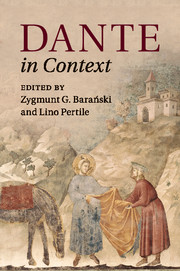Book contents
- Frontmatter
- Dedication
- Contents
- List of illustrations
- List of maps
- Notes on contributors
- Chronology
- Abbreviations and note on translations
- Introduction
- Part I Politics and society
- 1 Empire, Italy, and Florence
- 2 Economy
- 3 Law
- 4 Justice
- 5 Men and women
- 6 Church and orthodoxy
- 7 Heresy and dissidence
- 8 Daily life
- Part II Intellectual traditions
- Part III Linguistic and literary cultures
- Part IV Visual and performative culture
- Part V Dante: life, works, and reception
- Further reading
- Index
4 - Justice
from Part I - Politics and society
Published online by Cambridge University Press: 05 October 2015
- Frontmatter
- Dedication
- Contents
- List of illustrations
- List of maps
- Notes on contributors
- Chronology
- Abbreviations and note on translations
- Introduction
- Part I Politics and society
- 1 Empire, Italy, and Florence
- 2 Economy
- 3 Law
- 4 Justice
- 5 Men and women
- 6 Church and orthodoxy
- 7 Heresy and dissidence
- 8 Daily life
- Part II Intellectual traditions
- Part III Linguistic and literary cultures
- Part IV Visual and performative culture
- Part V Dante: life, works, and reception
- Further reading
- Index
Summary
Justice, in both its meanings of virtue and of political function, plays a central role in Dante's work. The Commedia is not only a great judicial machine, but also the result of a meditation that began with the lyric poetry, written in exile, and that culminated in the Monarchia. In the course of this analysis, Dante begins by identifying the triumph of injustice as the determining sign of the political crisis of his time, and concludes by finding a solution to the crisis in the idea of a universal empire, which, as the supreme political authority, would be able to restore justice and peace to the world. Dante's identification of the exercise of justice with political power along with his interpretation of the political crisis as a judicial crisis find their roots and explanation in the contemporary context.
Justice as social experience
In medieval Italian communes, citizens actively frequented the law courts. In Bologna, whose population reached around 50,000 in the last decade of the thirteenth century, the podestà's criminal court, where felonies were tried, alone held between 1,400 and 3,000 trials a year (the podestà was the official in charge of maintaining peace and justice in a city). Fifty years earlier, in Perugia, a city half the size of Bologna, the criminal courts hosted less than half this number of trials. It is thus likely that, during Dante's age, the number of trials, already high from the outset, continued to increase. Moreover, as research on Perugia has demonstrated, these trials came to involve in one role or another (accuser, accused, witness, and guarantor) around a quarter of the entire urban population, women and children included. The surviving evidence does not allow for similar estimates for Florence; however, it is safe to surmise that participation in the judicial system was equally, if not even more intense. From the time of Dante's great-great-grandfather Cacciaguida (c.1091–c.1148) to the poet's own, the number of courts consistently increased.
In Florence at the beginning of the twelfth century, the magistrates who dispensed justice were the consuls, the same who signed agreements with other cities, lords, and villages on behalf of the commune. They did so in a tribunal located near Orsanmichele, and they behaved almost like arbiters tasked in each case by the parties to find an agreement and settle the dispute.
- Type
- Chapter
- Information
- Dante in Context , pp. 59 - 70Publisher: Cambridge University PressPrint publication year: 2015

